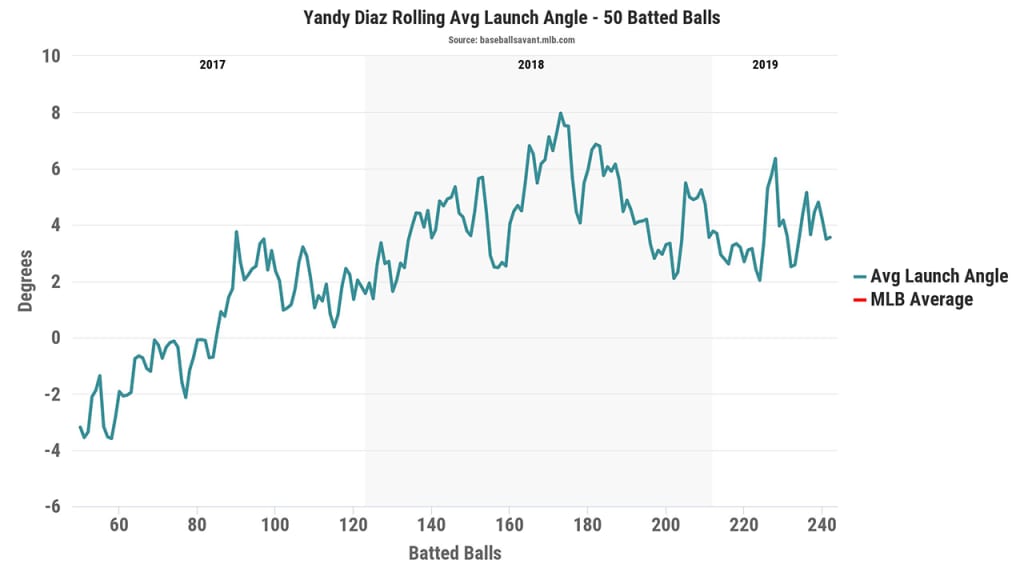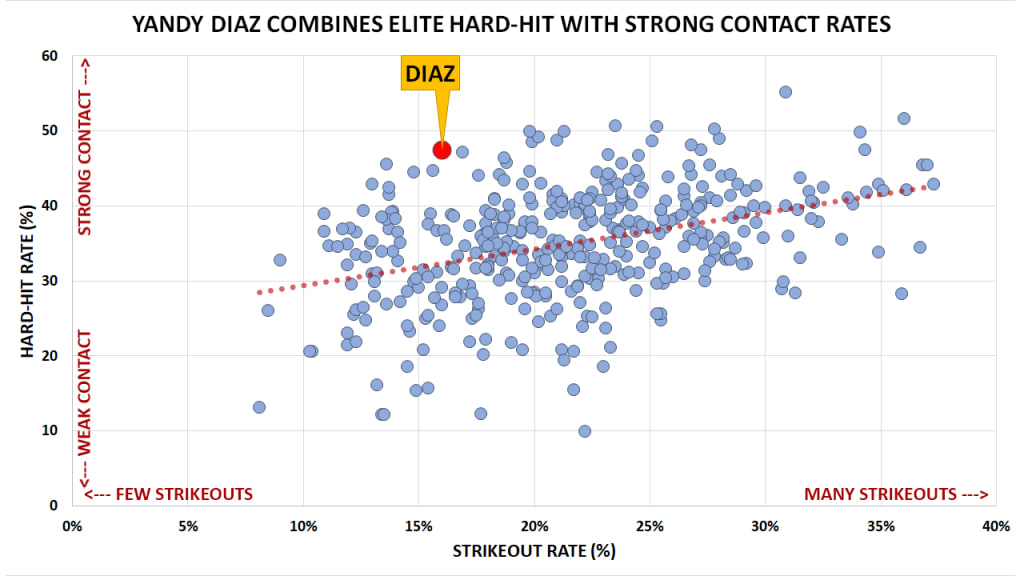In 1,099 plate appearances in 2017 and '18 -- that's 299 in the Majors, and 800 more at Triple-A -- Yandy Díaz hit a mere nine home runs, eight coming in the Minors.
In 44 plate appearances in 2019, his first with the Rays, Diaz already has three homers.
Usually, this wouldn't be more than a blip. Diaz will turn 28 in August, and he's never really hit for power. In parts of five seasons in the Cleveland Minor Leagues, he had an unimpressive .414 slugging percentage and 26 homers. Three homers in a week is nice, but we've seen weirder things, like last year when we saw relatively unheralded hitters like Matt Davidson, Christian Villanueva and Ronald Guzman hit three home runs in a game. Ketel Marte has three homers. Tim Beckham has four.
An older-ish prospect of relatively limited repute hitting a few dingers shouldn't exactly set off any alarm bells, yet this one does. This is the Diaz we've been waiting for, at least if you've been following the oft-frustrating world of talented hitters who crush the ball without actually finding success.
If you think the 8-3 Rays have a chance of maintaining their perch atop the American League East, Diaz matters. If you think the weakest-offense-in-the-AL Indians erred in letting Diaz go last winter, he matters. And if you think the ability to hit the ball really, really hard matters, Diaz matters.
He's a big deal -- do look at the now-famous 2016 picture of his massive biceps -- who just might be on his way to becoming a big deal. This is the story of the most interesting hitter you don't know, non-Willians Astudillo division.
A brief timeline of the Yandy infatuation on the baseball internet goes like this:
• In 2016, Diaz appeared at FanGraphs as a member of Carson Cistulli's "Fringe Five," which attempted to identify interesting prospects who weren't appearing on any major prospect lists. The long-running exercise went well enough that Cistulli was hired by the Blue Jays last year.
• In 2017, Diaz got into 49 games for the Indians and showed stunning hard-hit skills. There were 387 hitters who had 100 batted balls that year, and Diaz's 50.1 percent hard-hit rate was fifth-best, just ahead of Nelson Cruz and JD. Martinez.
Unfortunately, it was matched by a nearly-as-stunning inability to get the ball off the ground. Of those same 387 hitters, only 10 had a higher ground-ball rate than Diaz's 58.7 percent. In his time in the Minors, his 63.5 percent grounder rate was the highest of any upper level (Double-A or Triple-A) Minor Leaguer with 350 plate appearances.
As MLB.com's Jordan Bastian reported that year, Diaz and the Indians were both well aware of the issue, and work was put into fixing it.
• In 2018, Diaz again spent most of the year in the Minors, hitting the ball hard and on the ground, putting up a 52 percent grounder rate in the bigs and a 53 percent mark in the Minors.
In December, Diaz was traded from the Indians to the Rays in a deal where Tampa Bay had to give up young first baseman Jake Bauers and $5 million. In addition to Tommy Pham and Mike Zunino, the Rays acquired three of the top 26 hard-hit leaders from 2017-18.
"He's a guy we've been on for a while," said Chaim Bloom, the Rays' senior vice president of baseball operations. "We really like his bat. Yandy really hasn't had a chance to establish himself at the Major League level."
That brings us to 2019, where, on the second day of the season, Diaz did this.
That ball, hit at 112.2 mph off the bat, was the fourth time in his career he's touched 112 mph. As The Athletic (subscription required) recently delved into, hitting even one ball that hard can have a meaningful impact on your rest-of-season projections, because it's incredibly difficult to do. It's a skill.
“I haven’t seen a ball ever hit like that at this ballpark,” Rays manager Kevin Cash said. “That was impressive.”
(Cash wasn't wrong. Since Statcast came online in 2015, only two homers in Tampa Bay have been hit that hard and that low -- Diaz's and a Brad Miller blast from June 2016, though that was to left-center, not straightaway center.)
On Friday, Diaz somehow managed to muscle a ball out of Oracle Park while breaking his bat in the process. On Sunday, he spoke to MLB.com's Juan Toribio about his efforts to elevate.
“I’m not that type of a home-run hitter, but I’m doing better with my swing, trying to get the ball up in the air,” Diaz said. “And the results are getting there.”
And ... they are, aren't they? There's long been a misconception about "the launch angle hitter" in that they abandon all plate discipline in an attempt to hit the ball as high as they possibly can, but that's often not true, and it's definitely not true in Diaz's case. He doesn't need to be an extreme launch angle guy, and he's not. His average launch angle of 5.7 was a mere 119th of 134 hitters with 25 batted balls.
Yet it's getting higher, and that's the point. They might be low lasers, as that March 29 blast against the Astros showed. But so long as low lasers get over the fence and aren't right into the ground, they're high enough.

Besides, Diaz has always had another skill, and that's contact. Let's go all the way back to the 2016 MLB Pipeline scouting report, when he was Cleveland's No. 10 prospect.
"Diaz has proven to be one of the best and most disciplined hitters in the Indians' system," read the report. "[He] is a truly disciplined hitter who never ties to do too much and rarely expands his zone. ... He makes a lot of contact with his compact right-handed swing."
That was true then, and it's true now. Entering Monday's game -- in which he had two more hard-hit balls, singles at 104.1 mph and 110 mph, as well as two strikeouts -- Diaz had posted a 16.9 percent strikeout rate and a 47.1 percent hard-hit rate. Both are comfortably above average, and the two names nearest him on the leaderboard? Manny Machado and Matt Chapman. It's incredible company.

In this homer-happy, strikeout-prone age, sometimes there's value to just putting the bat on the ball, especially if you can hit it as hard as Diaz does. You can see what the Rays were interested in here.
But again, hitting the ball a lot is great, and hitting it hard is great. It just won't help you much if it's on the ground. Ask Eric Hosmer about that. Diaz has long been aware of it. So were the Indians. If the Rays can help him elevate just a little more, not a lot, then the sky is the limit.
That being the case, it's not just about raising that launch angle. It's about raising it where it matters, and where it matters is the hard-hit zone, 95 mph of exit velocity or higher. If you want to see where Diaz is truly making changes, just look there. Here's your secret sauce.
2017: 1.6 degrees
2018: 8.1 degrees
2019: 11.3 degrees
“I used to hit a lot of hard ground balls,” Diaz said to MLB.com on March 15. “But instead of keeping my top wrist down, I want to keep my swing through and not cut down my swing as much.”
“It’s not hard,” he continued. “The swing stays the same, but it’s more about the hands.”
It may sound easy, but it's not. After Monday's two-hit game, Diaz is now carrying a .308/.386/.615 line, with an equal number of walks (five) and strikeouts. (Meanwhile, Bauers fell apart in the second half last season and is hitting just .192/.276/.269 to start 2019.) Diaz has at least one hit in all but one of his starts this year.
The Rays gambled that they could tap into Diaz's power in a way that Cleveland couldn't. They bet that elite hard-hit skills and quality contact skills -- to go with solid enough defense at the corners -- were worth the $5 million and Bauers' entire career. He doesn't need to elevate a lot. Just a little. Those hard-hit lasers don't need a lot of help to get out.


